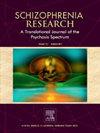情感性和非情感性精神病的海马体积
IF 3.5
2区 医学
Q1 PSYCHIATRY
引用次数: 0
摘要
非情感性精神障碍的海马体积变化始于前区,并随着疾病的进展扩散到后区。目前尚不清楚情感性精神病中是否也存在类似的海马体积变化。在这里,我们检验了海马前部和后部体积在情感性精神病中受到不同影响的假设。我们还调查了非典型海马发育的一个标志,不完全海马倒转(IHI)的患病率,以及它对情感性精神病海马体积的影响。我们对103名情感性精神病患者、242名非情感性精神病患者和214名健康对照者的结构MRI数据进行自动分割,分析了海马前部和后部的总体积。与健康受试者相比,情感性精神病患者海马后部体积较小。两组精神病患者在海马总体积或局部体积上无显著差异。非情感性和情感性精神病患者的IHI患病率和严重程度更高。我们的研究结果表明,情感性精神病患者的海马后部体积减少,而不是前部,因此IHI可能是患精神病风险增加的标志。本文章由计算机程序翻译,如有差异,请以英文原文为准。
Hippocampal volume in affective and non-affective psychosis
Hippocampal volume change in non-affective psychotic disorders begins in the anterior region and spreads to the posterior region as the illness progresses. It is unclear whether similar hippocampal volume changes are present in affective psychosis. Here, we test the hypothesis that anterior and posterior hippocampal volumes are differentially affected in affective psychosis. We also investigated the prevalence of a marker of atypical hippocampal development, incomplete hippocampal inversion (IHI), and its impact on hippocampal volume in affective psychosis. We analyzed total, anterior, and posterior hippocampal volumes using automated segmentation of structural MRI data from 103 affective psychosis, 242 non-affective psychosis, and 214 healthy control individuals. Compared to healthy participants, individuals with affective psychosis exhibited smaller posterior hippocampal volumes. The two psychosis patient groups did not differ significantly in total or regional hippocampal volumes. IHI prevalence and severity were greater in individuals with non-affective and affective psychosis. Our findings suggest hippocampal volume is reduced in the posterior, but not anterior, hippocampus in affective psychosis and that IHI may be a marker for an increased risk of developing psychosis.
求助全文
通过发布文献求助,成功后即可免费获取论文全文。
去求助
来源期刊

Schizophrenia Research
医学-精神病学
CiteScore
7.50
自引率
8.90%
发文量
429
审稿时长
10.2 weeks
期刊介绍:
As official journal of the Schizophrenia International Research Society (SIRS) Schizophrenia Research is THE journal of choice for international researchers and clinicians to share their work with the global schizophrenia research community. More than 6000 institutes have online or print (or both) access to this journal - the largest specialist journal in the field, with the largest readership!
Schizophrenia Research''s time to first decision is as fast as 6 weeks and its publishing speed is as fast as 4 weeks until online publication (corrected proof/Article in Press) after acceptance and 14 weeks from acceptance until publication in a printed issue.
The journal publishes novel papers that really contribute to understanding the biology and treatment of schizophrenic disorders; Schizophrenia Research brings together biological, clinical and psychological research in order to stimulate the synthesis of findings from all disciplines involved in improving patient outcomes in schizophrenia.
 求助内容:
求助内容: 应助结果提醒方式:
应助结果提醒方式:


